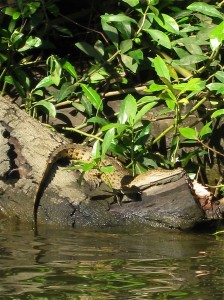Ocean Currents are Highways for Crocodiles
/https://tf-cmsv2-smithsonianmag-media.s3.amazonaws.com/filer/20110520102351IMG_0528.JPG)

Ocean currents have carried a huge variety of things around the world, from trash to shipwrecked Japanese sailors. And crocodiles, according to a new study in the Journal of Animal Ecology.
The estuarine crocodile (Crocodylus porosus) lives in rivers, estuaries and mangrove swamps throughout much of the South-East Pacific, from Fiji to East India, from North Australia to southern China, a range of nearly 4,000 square miles. But these crocodiles rely on land to find food and freshwater, and swimming across the seas would seem to require more aerobic activity than a lazy croc could muster up. How did they become distributed in so many remote places across the region?
A team of researchers in Australia (including the late Steve Irwin) tagged 27 adult crocodiles from the Kennedy River with sonar transmitters and tracked their movements over 12 months. They also re-analyzed older data from a handful of crocs that had been tracked by satellite (the sonar transmitters have a shorter range). Both male and female crocodiles regularly traveled 30 miles or more from their river home out into the ocean sea. And one of the satellite-tagged crocs traveled more than 350 miles. The animals weren't actively swimming wherever they wanted, however. They timed their journeys to use the tides and surface currents and stopped when the tide turned. And their travels were not one way---they returned home.
How do these reptiles survive an ocean journey? Scientists have found that small crocodiles (about 22 pounds) can survive for up to four months in seawater without feeding and suspect that a large adult would be able to last much longer. The reptiles have extra salt-secreting glands---similar to those in marine turtles---that would let them get rid of excess salt, and they would likely be able to survive for quite a long time on their last meal and the water obtained through their metabolisms.
The new data makes ocean sightings of crocodiles over the years understandable, and it provides an explanation for how the species became so widespread. The researchers suggest that the crocs may regularly invade islands throughout the region, which could account how the species has remained intact and not diversified into several independent species. The study may even explain how the various crocodile species around the world came into being, the scientists say: One ocean-going ancestral species may have traveled the seas and colonized new habitats, and those populations would then have evolved into the crocs we know today.
Ocean currents have carried a huge variety of things around the world, from trash to shipwrecked Japanese sailors. And crocodiles, according to a new study in the Journal of Animal Ecology.
The estuarine crocodile (Crocodylus porosus) lives in rivers, estuaries and mangrove swamps throughout much of the South-East Pacific, from Fiji to East India, from North Australia to southern China, a range of nearly 4,000 square miles. But these crocodiles rely on land to find food and freshwater, and swimming across the seas would seem to require more aerobic activity than a lazy croc could muster up. How did they become distributed in so many remote places across the region?
A team of researchers in Australia (including the late Steve Irwin) tagged 27 adult crocodiles from the Kennedy River with sonar transmitters and tracked their movements over 12 months. They also re-analyzed older data from a handful of crocs that had been tracked by satellite (the sonar transmitters have a shorter range). Both male and female crocodiles regularly traveled 30 miles or more from their river home out into the ocean sea. And one of the satellite-tagged crocs traveled more than 350 miles. The animals weren't actively swimming wherever they wanted, however. They timed their journeys to use the tides and surface currents and stopped when the tide turned. And their travels were not one way---they returned home.
How do these reptiles survive an ocean journey? Scientists have found that small crocodiles (about 22 pounds) can survive for up to four months in seawater without feeding and suspect that a large adult would be able to last much longer. The reptiles have extra salt-secreting glands---similar to those in marine turtles---that would let them get rid of excess salt, and they would likely be able to survive for quite a long time on their last meal and the water obtained through their metabolisms.
The new data makes ocean sightings of crocodiles over the years understandable, and it provides an explanation for how the species became so widespread. The researchers suggest that the crocs may regularly invade islands throughout the region, which could account how the species has remained intact and not diversified into several independent species. The study may even explain how the various crocodile species around the world came into being, the scientists say: One ocean-going ancestral species may have traveled the seas and colonized new habitats, and those populations would then have evolved into the crocs we know today.
/https://tf-cmsv2-smithsonianmag-media.s3.amazonaws.com/accounts/headshot/Sarah-Zielinski-240.jpg)
/https://tf-cmsv2-smithsonianmag-media.s3.amazonaws.com/accounts/headshot/Sarah-Zielinski-240.jpg)